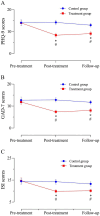The effect of pressing needle therapy on depression, anxiety, and sleep for patients in convalescence from COVID-19
- PMID: 39744118
- PMCID: PMC11688403
- DOI: 10.3389/fneur.2024.1481557
The effect of pressing needle therapy on depression, anxiety, and sleep for patients in convalescence from COVID-19
Abstract
Objective: To evaluate the effect of pressing needle therapy on depression, anxiety, and sleep in patients recovering from COVID-19, and to provide a more effective and convenient treatment for the sequelae of COVID-19.
Methods: A total of 136 patients recovering from COVID-19 were randomized into a treatment group (68 cases) and a control group (68 cases, with one case dropping out). The treatment group received pressing needle therapy, while the control group received sham pressing needle therapy, three times a week for 4 weeks. The Patient Health Questionnaire (PHQ-9), Generalized Anxiety Disorder Scale (GAD-7), and Insomnia Severity Index (ISI) were used to evaluate patients' emotional states and sleep quality. These scales were assessed before, after, and at a 1-month follow-up.
Results: Compared to before treatment, the treatment group showed a significant decrease in PHQ-9 scores (p < 0.05, Cohen's d = 1.26), GAD-7 scores (p < 0.05, Cohen's d = 1.10), and ISI scores (p < 0.05, Cohen's d = 0.94) after treatment. Similarly, at the 1-month follow-up, significant decreases were observed in PHQ-9 scores (p < 0.05, Cohen's d = 1.11), GAD-7 scores (p < 0.05, Cohen's d = 0.88), and ISI scores (p < 0.05, Cohen's d = 0.94). In contrast, the control group demonstrated no statistically significant differences in PHQ-9, GAD-7, or ISI scores after treatment or at the 1-month follow-up (p > 0.05). Between the two groups, statistically significant improvements (p < 0.05) were observed in PHQ-9 scores (Cohen's d = 1.47), GAD-7 scores (Cohen's d = 1.61), and ISI scores (Cohen's d = 1.06) after treatment. At the 1-month follow-up, statistically significant differences (p < 0.05) between the two groups were also noted in PHQ-9 scores (Cohen's d = 1.10), GAD-7 scores (Cohen's d = 0.87), and ISI scores (Cohen's d = 0.92).
Conclusion: Pressing needle therapy significantly improves the mental health and sleep quality of patients recovering from COVID-19. It enhances their quality of life, promotes early recovery, and is simple and easy to administer, making it a treatment worthy of clinical application.
Clinical trial registration: https://www.chictr.org.cn/.
Keywords: COVID-19; anxiety; depression; pressing needle therapy; sleep.
Copyright © 2024 Liang, Tang, Li, Zhao, Yu, Li, Wang, Cun, Gao and Yang.
Conflict of interest statement
The authors declare that the research was conducted in the absence of any commercial or financial relationships that could be construed as a potential conflict of interest.
Figures




Similar articles
-
The efficacy of a transdiagnostic group cognitive behavioral intervention for Chinese elderly with emotional disorders: A one-year follow-up randomized clinical trial.Front Psychiatry. 2022 Nov 25;13:1027994. doi: 10.3389/fpsyt.2022.1027994. eCollection 2022. Front Psychiatry. 2022. PMID: 36506431 Free PMC article.
-
Treating depression with a smartphone-delivered self-help cognitive behavioral therapy for insomnia: a parallel-group randomized controlled trial.Psychol Med. 2023 Apr;53(5):1799-1813. doi: 10.1017/S0033291721003421. Epub 2021 Aug 23. Psychol Med. 2023. PMID: 37310329 Clinical Trial.
-
The Association of Insomnia with Depression and Anxiety Symptoms in Patients Undergoing Noncardiac Surgery.Neuropsychiatr Dis Treat. 2021 Mar 25;17:915-924. doi: 10.2147/NDT.S296986. eCollection 2021. Neuropsychiatr Dis Treat. 2021. PMID: 33790560 Free PMC article.
-
Positive impacts of e-aid cognitive behavioural therapy on the sleep quality and mood of nurses on site during the COVID-19 pandemic.Sleep Breath. 2022 Dec;26(4):1947-1951. doi: 10.1007/s11325-021-02547-1. Epub 2022 Jan 8. Sleep Breath. 2022. PMID: 34997900 Free PMC article.
-
Hatha yoga for acute, chronic and/or treatment-resistant mood and anxiety disorders: A systematic review and meta-analysis.PLoS One. 2018 Oct 1;13(10):e0204925. doi: 10.1371/journal.pone.0204925. eCollection 2018. PLoS One. 2018. PMID: 30273409 Free PMC article.
Cited by
-
Facial edema after covid-19 ameliorated by acupuncture: A CARE-compliant case report.Medicine (Baltimore). 2025 Jul 18;104(29):e43407. doi: 10.1097/MD.0000000000043407. Medicine (Baltimore). 2025. PMID: 40696628 Free PMC article.
References
-
- Li Z, Wang M, Wang J, Cao C, Pu Y. Psychological evaluation and intervention strategies of patients with infectious diseases in isolation observation Ward of a hospital during COVID-19 pandemic. Anti Infect Pharm. (2021) 18:1669–74. doi: 10.13493/j.issn.1672-7878.2021.11-032 - DOI
LinkOut - more resources
Full Text Sources

